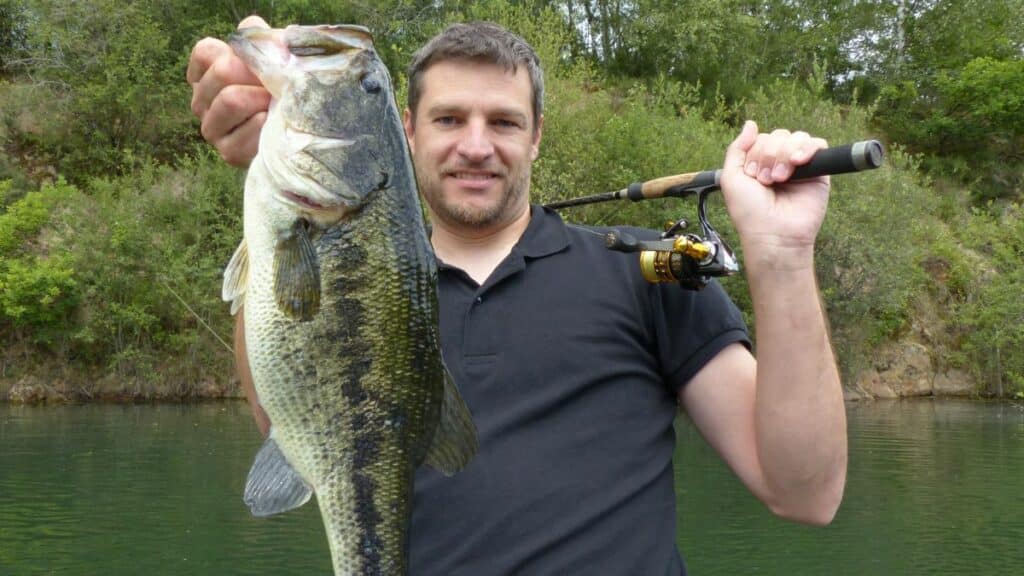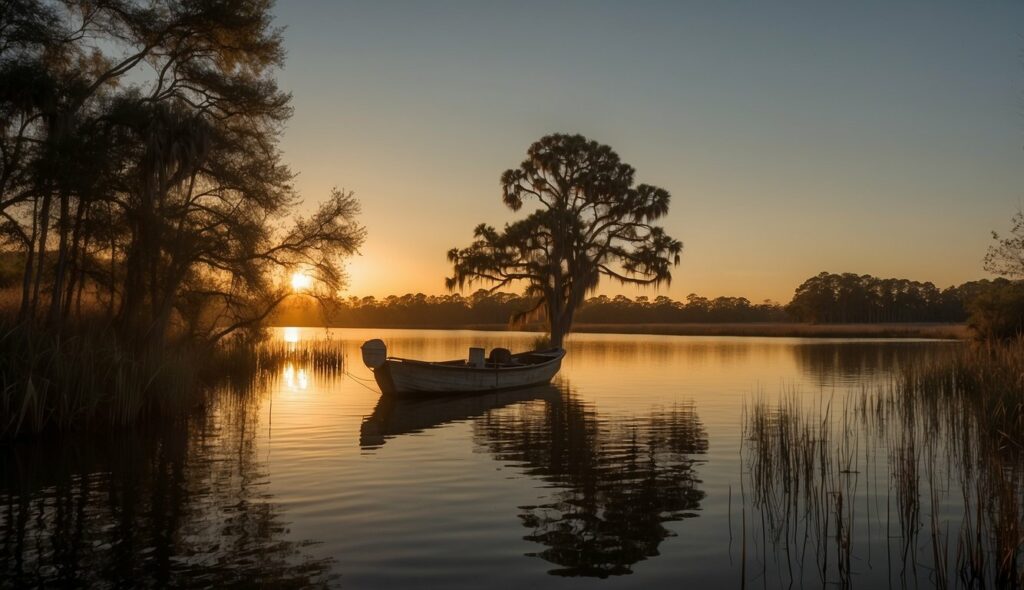Learning how to fish for bass opens up a world of excitement, challenge, and reward. Whether you’re a novice or an experienced angler, mastering bass fishing demands both knowledge and skill. In this guide, we explore gear selection, understanding bass behavior, casting techniques, and navigating fishing environments. Join us as we uncover the secrets of successful bass fishing, whether you’re aiming for trophies or seeking serenity on the water.
Understanding Bass Behavior
To effectively fish for bass, you need to comprehend their seasonal behaviors and habitats. Bass adjust their locations and feeding habits to the changing conditions of their environment throughout the year.
Spring Movement and Feeding Patterns
In spring, bass move from deeper waters to shallow areas to spawn when water temperatures reach about 60-65 degrees. You’ll find them in zones with hard bottoms as they prepare for the spawn. During pre-spawn, bass aggressively feed to fuel the energy-intensive spawning process. The right lure can make a significant difference in these conditions, ensuring you capitalize on their heightened activity.
Summer Patterns and Bass Locations
As summer sets in and water temperatures rise, bass often seek deeper, cooler waters during the heat of the day. Look for bass around structure and cover such as submerged trees, drop-offs, or weed beds as they provide shelter and a rich supply of baitfish. Morning and evening are peak feeding times since bass escape the warm temperatures and become more active. Focusing on areas with ample vegetation can lead to successful outings.
Fall Transition and Behavior
In fall, bass experience a period of adjustment as they follow migratory paths of prey in response to cooler water temperatures. They’ll often feed heavily, anticipating the coming winter. Target areas where baitfish are abundant, as bass will likely be in pursuit. Shallow water can yield results as bass become active throughout the day, enjoying the moderate temperatures.
Winter Downtime
Winter signifies a slowdown in bass activity as they conserve energy in cold water, reducing their feeding frequency. During this time, bass prefer deeper areas where the water temperature is more stable but will occasionally venture to shallower waters on warmer days. Slow-moving baits presented in their vicinity can persuade a lethargic bass to bite. Fishing in areas with minimal current can increase your chances as these locations require less energy expenditure for bass to maintain position.
Choosing the Right Tackle
Selecting the proper tackle is crucial for successful bass fishing. Your rod, reel, and line choices need to be well-suited to the baits you plan to use, allowing for precision and efficiency in casting and retrieving.
Rod Selection
When targeting bass, the right rod plays a critical role in casting accuracy and sensitivity to bites. For versatility, a medium-heavy rod around 6’6″ to 7′ in length is a staple among anglers. It offers a good balance of power for setting the hook and flexibility for different bass lures.
Reel Types
Your choice of reel is predominantly between a spinning reel and a baitcasting reel. Spinning reels are user-friendly, suitable for lighter lines and baits, whereas baitcasting reels offer greater control and are preferred for heavier lures and lines. A well-balanced setup allows you to cast with precision and manage your line effectively during retrieval.
Line Choices
Line selection can be the deciding factor between landing a catch and a missed opportunity. Bass fishing commonly involves monofilament or fluorocarbon lines, which are versatile and offer good knot strength. Monofilament is forgiving and stretchy, great for topwater lures, while fluorocarbon’s lower visibility makes it a choice for clear waters. Choose a line weight that aligns with your rod’s and reel’s specifications, as well as the cover you’ll be fishing in.
Lure Selection and Usage
Selecting the right bass lures is vital for successful fishing, as is understanding when and how to use them effectively. Your technique, combined with the proper lure, can turn a day of fishing into a memorable haul.
Spinnerbaits and Crankbaits
Spinnerbaits are versatile lures that are particularly effective in murky water or heavy cover. They create vibration and flash that can mimic the movements of small baitfish. When using spinnerbaits, focus on a steady retrieval rate and allow the blades to do the work. For crankbaits, choose square bill variations for shallow water and stubby-lipped versions when maneuvering around wood or rock. Medium-diving crankbaits are best suited for waters in the 5-10 foot range, while deep-diving crankbaits are the go-to for depths of 12 feet or more. Always consider the color of your crankbaits; natural hues work well in clear water, while brighter, more striking colors are effective in stained or dirty water.
Jigs and Soft Plastics
Jigs are the bread and butter for many bass anglers, perfect for fishing along the bottom. With jigs, you should master the lift-and-drop technique where you let the jig touch down on the bottom before bringing it up again—this simulates a struggling prey. Pair jigs with soft plastics to add visual appeal and the feel of a live bait. Soft plastics come in numerous forms, such as worms, lizards, and craws. Rig them Texas style for weedless performance or Carolina style when you need the lure to stay off the bottom. Experiment with colors and shapes to entice the bass, but always lean towards natural colors that mimic local forage.
Topwater Lures and Frogs
Topwater lures bring an unmatched excitement to bass fishing, with heart-stopping surface strikes. They work best during low light conditions—dawn, dusk, or overcast days. Walking the dog or popping techniques can be very successful, varying retrieval speeds to find what triggers the bass. Frogs are excellent topwater options, particularly in lily pads or heavy vegetation where bass are lurking. Cast beyond your target and bring the frog back with short, sharp jerks to imitate a live frog’s movement. Brightly colored frogs can be great in dirty water, whereas a more subdued color palette may work better in clear conditions. Remember, with topwater lures and frogs, patience is key—wait to feel the weight of the fish before setting the hook.
Techniques for Casting and Retrieval
Mastering the techniques of casting and retrieval is essential for successful bass fishing. These skills determine not only how effectively you can place your lure but also manipulate it to entice bass.
Casting Accuracy and Distance
To achieve Casting Accuracy, start by focusing on a target and practice your cast to hit it consistently. A balanced combination of rod, reel, and line type enhances your precision. Distance comes with practice, as well as selecting the appropriate tackle that suits your physical strength and skill level. Consider using drills to improve your casting accuracy, much like those used by athletes to hone their sport-specific skills.
Retrieval Speed and Rhythm
Your Retrieval Speed should vary as bass can strike at different rates depending on weather, water conditions, and mood. A slow retrieve can be tempting for bass, suggesting an easy target, whereas a faster pace can trigger their predatory instinct. Rhythm plays a key role, too; steady retrieves are predictable, but by introducing pauses or changes in speed, you can make your lure more appealing. Learn techniques to fish bass fishing lures effectively by mixing up retrieval speeds.
Structural Fishing Techniques
Structure Fishing focuses on targeting areas where bass are likely to hide or hunt, such as sunken trees, weed beds, or drop-offs. Use your knowledge of the water body you’re fishing in to cast to these structures effectively. Your approach should be methodical: cast beyond the structure and retrieve your lure so that it passes by compellingly. Tactics like punching a jig work well in dense cover, while other techniques may work better in open water adjacent to structure.
Reading Water and Weather Conditions
When targeting bass, understanding how water clarity, depth, and weather impact their behavior is crucial. By interpreting these conditions, you can adjust your strategy to increase your chances of a successful outing.
Analyzing Water Clarity and Depth
Water clarity directly influences bass visibility and feeding patterns. In clear water, bass rely heavily on sight to catch prey, making them more likely to be found in deeper waters away from predators. However, murky conditions lead bass to rely on other senses and typically stay in shallower areas. Bass often prefer areas where they can use changes in depth as escape routes, which should be noted on your depth finder or map.
- Clear Conditions: Target deeper structures and transitions between depths.
- Murky Conditions: Fish shallower waters or around cover where bass may be hiding.
Effect of Weather Patterns on Bass Fishing
Weather patterns play a significant role in determining bass behavior. On cloudy days or in low light conditions, bass are more active and likely to hunt in shallow waters or around structures; using moving baits can be effective during these times. Conversely, high sunlight leads to bass seeking shade or deeper waters. Additionally, wind can create water disturbances that bass may use to ambush prey.
- Sunlight & Shade: Bass may seek refuge under cover or in shaded areas during bright conditions.
- Wind: Windy conditions can be beneficial as they disperse baitfish, drawing bass out to feed.
Weather changes can also trigger feeding activity; notably, bass often feed more aggressively right before a change in weather, such as an incoming storm, due to lower barometric pressure. Understanding and tracking water temperature is also paramount, as temperature affects bass metabolism and thereby their feeding habits. Bass are typically more active in warmer water but can be found in cooler temperatures in certain circumstances.
- Storm Approaching: Increased bass activity can be expected with the drop in pressure.
- Water Temperature: Keep a record of temperatures; bass behavior varies with changes in degree.
Adjust your tactics in response to these environmental cues to enhance your bass fishing results.
Bass Fishing Strategies
To successfully capture bass, you need to adapt your strategy based on the fishing environment. Whether you’re casting near the shoreline or venturing into deeper waters, understanding the nuances of each habitat—like the presence of docks or vegetation—is crucial.
Shoreline and Dock Fishing
When fishing for bass along the shore or around docks, focus on areas where bass seek shelter and hunt for prey. Docks provide excellent cover with their submerged structures. It’s best to use lures that mimic local baitfish and cast close to the pilings. For shore fishing, look for irregularities such as protruding rocks, stumps, or patches of grass. Cast parallel to the shore to keep your lure in the strike zone longer.
Deep Water Tactics
Bass often retreat to deeper waters, especially during midday when the surface heats up. Utilize deep water strategies by identifying underwater structures like ledges, drop-offs, or submerged islands using a fish finder. Vertical jigging or using deep-diving crankbaits can be particularly effective. Remember, the key to deep water bass fishing is patience—bass may take longer to strike in these areas.
Vegetation and Cover Strategies
Bass use vegetation like lily pads, wood, and submerged grass as hiding spots to ambush prey. Casting into these areas with weedless lures can yield impressive results. Use a topwater frog over lily pads or flip and pitch soft plastics into denser cover. When targeting bass in areas with rocks or wood, use a Texas-rigged worm or creature bait to minimize snags while maintaining an enticing presentation.
Fishing Etiquette and Conservation
In the pursuit of bass fishing, it’s crucial to adhere to ethical practices that ensure not only a good experience for yourself but also the preservation of fish populations and their habitats. By respecting both the fish and fellow anglers, you can contribute positively to the sport’s future.
Respectful Fishing Practices
When fishing for bass, always observe local regulations and respect other anglers’ space. Be patient and take care not to crowd others or fish too close to another’s line. Always seek permission before fishing on private land, and avoid making excessive noise that could disrupt both the fish and your fellow anglers. Maintain cleanliness around waterways by removing any trash you create or find, thereby preserving the natural ambush points where bass often hide.
- Abide by Laws: Familiarize yourself with and follow state-specific fishing seasons and catch limits.
- Sharing Spaces: Understand that prime fishing spots are best enjoyed by taking turns and acknowledging other anglers’ right to fish.
Catch and Release Best Practices
The conservation of bass populations relies heavily on catch and release practices. To ensure that bass are released successfully and unharmed:
- Use the appropriate hooks: Employ circle hooks when possible to minimize harm to the bass.
- Handle with care: When removing the hook, be gentle, support the bass horizontally, and avoid squeezing or placing fingers in the gills. Return the fish to the water promptly.
Leveraging these practices will help maintain the bass stock for future successful fishing experiences while also showing respect for the natural ecosystem.
Advanced Techniques and Tips
Mastering advanced techniques and leveraging a deep understanding of a bass’s behavior will significantly increase your success rates. Here, we’ll explore how to capitalize on seasonal tactics and bass feeding habits to catch more bass.
Seasonal Tactics
Spring:
- Pre-Spawn: Focus on shallow waters with slow-moving lures that mimic a bass’s natural prey.
- Spawn: Target bass near bedding areas, using techniques that protect the natural ecosystem while employing natural-colored soft plastics.
Summer:
- Seek out deeper, cooler water structures.
- Use crankbaits and deep-diving lures to reach lethargic bass.
Fall:
- Early Fall: Capitalize on bass feeding frenzies with topwater lures and spinnerbaits.
- Late Fall: Switch to jigs and slow-moving baits in deeper areas as water temperatures drop.
Winter:
- Apply finesse tactics with lighter tackle and smaller baits.
- Slowly drag a jig or throw a drop shot rig to entice cold bass in deeper water.
Leveraging Bass Feeding Habits
- Morning: Utilize topwater baits when bass are actively feeding on surface prey.
- Afternoons to Evenings: Shift to structure-based fishing, using crankbaits along drop-offs and rocky outcrops.
- Understanding Baitfish: Use lures that closely resemble the local baitfish in terms of size, shape, and color for improved results.
- Live Bait: When using live bait, ensure it’s lively and well-presented, appealing to the bass’s predatory instincts.
By incorporating these advanced tactics and seasonal strategies, you will enhance your ability to effectively fish for bass, maximizing your efforts on the water.
Frequently Asked Questions
In this section, you’ll find concise answers to some of the most common questions about bass fishing to help you get started and improve your skills.
What is the best bait to use for catching bass?
Natural baits like crawfish, minnows, and leeches are often effective for catching bass due to their familiarity in the bass’s diet. However, artificial bass fishing rigs and lures that mimic these natural baits can also be quite successful.
Which lures are most effective for bass fishing?
For bass fishing, crankbaits, spinnerbaits, and plastic worms are among the most effective lures. They have proven successful over time due to their ability to cover water efficiently and attract bass through movement and vibration.
What are essential tips for beginners starting bass fishing?
If you’re starting bass fishing, focus on learning how to cast accurately, read water conditions, and select the right gear. Start by fishing in smaller lakes and ponds which are often stocked with bass and offer simpler conditions for practicing your technique.
How can you successfully fish for bass from the shore?
Fishing for bass from the shore requires strategic casting towards areas where bass are likely to hide, such as weed beds, rocks, or submerged structures. Also, utilize a range of retrieval speeds and styles to see which one attracts bass in your specific location.
What are some innovative techniques for catching bass more effectively?
Experiment with different fishing methods like drop shotting, flick shaking, or using Alabama rigs to present baits in unique manners that can provoke bass to bite. Stay updated with current trends and bass fishing questions for more innovative techniques.
At what depth are you most likely to find bass in a body of water?
Bass can often be found at depths where the water temperature and oxygen levels are most comfortable, which typically range from 2 to 20 feet. But remember, factors like time of year, water clarity, and fishing conditions can significantly alter the depth at which bass will be most active.
Meet Eric McGough, a seasoned adventurer and military veteran who traded his tech career for a life of outdoor exploration and freedom. He plans to travel the world, discover new adventures, and share information about great destinations, gear, and more on the Shaman Mountain Sports and Outdoors Blog.





